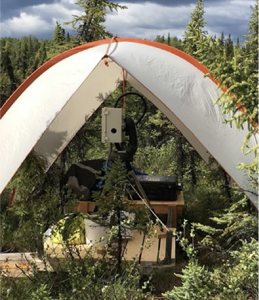D. Michelle Bailey, Erin M. Adkins, and J. Houston Miller
Appl. Phys. B (2017) 123:245
We have developed a low-power, open-path, near-infrared (NIR) tunable diode laser sensor for the measurement of near ground-level concentrations of greenhouse gases. Here, we report on instrument design, characterization, and initial measurements of carbon dioxide concentrations during deployment to a thermokarst collapse scar bog near Fairbanks, AK (USA). The optics “launch-box” portion of the instrument couples radiation from an NIR, distributed feedback diode laser operating near 1572 nm with a visible laser for alignment purposes. The outgoing beam is directed through a 3.2-mm hole in a parabolic mirror and the launchbox is oriented using a two axis, altitude-azimuth telescope mount such that the beam strikes a retroreflector target at a set distance downfield. The beam then retraces the path back to the launch-box where the light is collected on the surface of the parabolic mirror and focused onto a multimode fiber that transfers the radiation to an InGaAs detector. Sweeps over a ~1.6 cm-1 spectral region were collected at a rate of 500 scans per second and were typically stored as 10 s sweep averages. These averaged sweeps could be individually spectrally fit for CO2 concentration or averaged into a single spectrum for fitting (after correction for slight frequency drift). Field data reported here was averaged for 2.5 min and was found to follow trends in diurnal cycles of CO2 concentration cycles reported by sensors located nearby in the field site.

